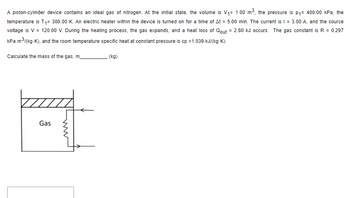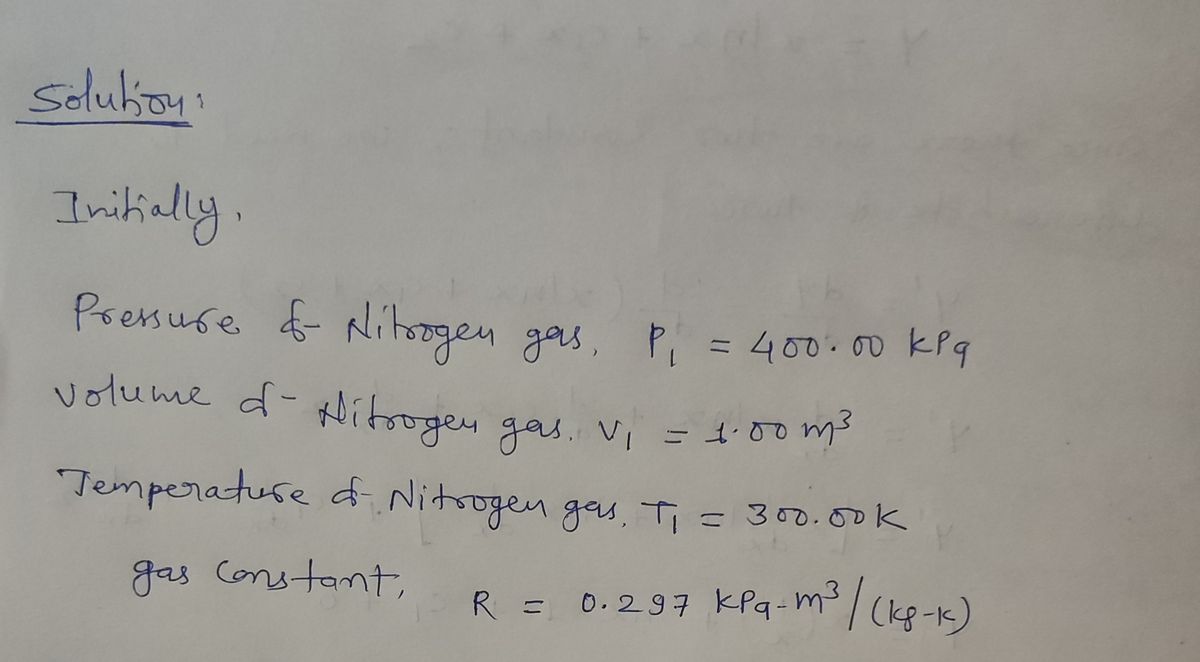
Elements Of Electromagnetics
7th Edition
ISBN: 9780190698614
Author: Sadiku, Matthew N. O.
Publisher: Oxford University Press
expand_more
expand_more
format_list_bulleted
Concept explainers
Question
A piston-cylinder device contains an ideal gas of nitrogen. At the initial state, the volume is V1= 1.00 m3, the pressure is p1= 400.00 kPa, the temperature is T1= 300.00 K. An electric heater within the device is turned on for a time of Δt = 5.00 min. The current is I = 3.00 A, and the source voltage is V = 120.00 V. During the heating process, the gas expands, and a heat loss of Qout = 2.80 kJ occurs. The gas constant is R = 0.297 kPa·m3/(kg·K), and the room temperature specific heat at constant pressure is cp =1.039 kJ/(kg·K).
Calculate the mass of the gas, m__________ (kg)

Transcribed Image Text:**Transcription of the Educational Content:**
A piston-cylinder device contains an ideal gas of nitrogen. At the initial state, the volume is \( V_1 = 1.00 \, \text{m}^3 \), the pressure is \( p_1 = 400.00 \, \text{kPa} \), and the temperature is \( T_1 = 300.00 \, \text{K} \). An electric heater within the device is turned on for a time of \( \Delta t = 5.00 \, \text{min} \). The current is \( I = 3.00 \, \text{A} \), and the source voltage is \( V = 120.00 \, \text{V} \). During the heating process, the gas expands, and a heat loss of \( Q_{\text{out}} = 2.80 \, \text{kJ} \) occurs. The gas constant is \( R = 0.297 \, \text{kPa} \cdot \text{m}^3/(\text{kg} \cdot \text{K}) \), and the room temperature specific heat at constant pressure is \( c_p = 1.039 \, \text{kJ}/(\text{kg} \cdot \text{K}) \).
Calculate the mass of the gas, \( m \) (kg).
**Diagram Explanation:**
The diagram shows a schematic of a piston-cylinder device. It contains the following elements:
- A cylinder with a movable piston at the top.
- The word "Gas" indicates the contents inside the cylinder.
- A symbol representing an electric heater is shown at the bottom, indicating where heat is added to the system.
This setup illustrates the principles of thermodynamics with respect to gas behavior and heat transfer in a piston-cylinder system.
Expert Solution
arrow_forward
Step 1

Step by stepSolved in 2 steps with 2 images

Knowledge Booster
Learn more about
Need a deep-dive on the concept behind this application? Look no further. Learn more about this topic, mechanical-engineering and related others by exploring similar questions and additional content below.Similar questions
- When an ideal gas undergoes isothermal compression as a closed system, its specific internal energy Decreases Does not change O Increasesarrow_forwardN = 0 An insulated tank of volume 10+(10+N)/25 m and with a valve was filled with perfect tri- atomic gas at pressure 10 bar, where N is equal to the last two digitals in your student's ID number. Initially the valve was closed. A paddle wheel was mounted inside the tank and was run by 20 kW engine. The paddle wheel was turn on and at the same time the exit valve was opened. The gas temperature was constant though the whole process (due to very slow flow) and equal to 300 K. Calculate the time needed to decrease the pressure in the tank to 5 bar.arrow_forwardA typical gasoline (β=0.00095/°C) tank can hold 65 liters (~17 gallons). At the gas station, the storage tank is underground and is maintained at a temperature of 50.0°F. On a hot day at 103.0°F you fill your empty tank. (a) What is the equivalent temperature difference in °C? A typical gasoline (β=0.00095/°C) tank can hold 65 liters (~17 gallons). At the gas station, the storage tank is underground and is maintained at a temperature of 50.0°F. On a hot day at 103.0°F you fill your empty tank. (c) How much gas should you put in your car on this hot day at so that it will fill (not overfill) the tank when it expands to 103.0°F?arrow_forward
arrow_back_ios
arrow_forward_ios
Recommended textbooks for you
 Elements Of ElectromagneticsMechanical EngineeringISBN:9780190698614Author:Sadiku, Matthew N. O.Publisher:Oxford University Press
Elements Of ElectromagneticsMechanical EngineeringISBN:9780190698614Author:Sadiku, Matthew N. O.Publisher:Oxford University Press Mechanics of Materials (10th Edition)Mechanical EngineeringISBN:9780134319650Author:Russell C. HibbelerPublisher:PEARSON
Mechanics of Materials (10th Edition)Mechanical EngineeringISBN:9780134319650Author:Russell C. HibbelerPublisher:PEARSON Thermodynamics: An Engineering ApproachMechanical EngineeringISBN:9781259822674Author:Yunus A. Cengel Dr., Michael A. BolesPublisher:McGraw-Hill Education
Thermodynamics: An Engineering ApproachMechanical EngineeringISBN:9781259822674Author:Yunus A. Cengel Dr., Michael A. BolesPublisher:McGraw-Hill Education Control Systems EngineeringMechanical EngineeringISBN:9781118170519Author:Norman S. NisePublisher:WILEY
Control Systems EngineeringMechanical EngineeringISBN:9781118170519Author:Norman S. NisePublisher:WILEY Mechanics of Materials (MindTap Course List)Mechanical EngineeringISBN:9781337093347Author:Barry J. Goodno, James M. GerePublisher:Cengage Learning
Mechanics of Materials (MindTap Course List)Mechanical EngineeringISBN:9781337093347Author:Barry J. Goodno, James M. GerePublisher:Cengage Learning Engineering Mechanics: StaticsMechanical EngineeringISBN:9781118807330Author:James L. Meriam, L. G. Kraige, J. N. BoltonPublisher:WILEY
Engineering Mechanics: StaticsMechanical EngineeringISBN:9781118807330Author:James L. Meriam, L. G. Kraige, J. N. BoltonPublisher:WILEY

Elements Of Electromagnetics
Mechanical Engineering
ISBN:9780190698614
Author:Sadiku, Matthew N. O.
Publisher:Oxford University Press

Mechanics of Materials (10th Edition)
Mechanical Engineering
ISBN:9780134319650
Author:Russell C. Hibbeler
Publisher:PEARSON

Thermodynamics: An Engineering Approach
Mechanical Engineering
ISBN:9781259822674
Author:Yunus A. Cengel Dr., Michael A. Boles
Publisher:McGraw-Hill Education

Control Systems Engineering
Mechanical Engineering
ISBN:9781118170519
Author:Norman S. Nise
Publisher:WILEY

Mechanics of Materials (MindTap Course List)
Mechanical Engineering
ISBN:9781337093347
Author:Barry J. Goodno, James M. Gere
Publisher:Cengage Learning

Engineering Mechanics: Statics
Mechanical Engineering
ISBN:9781118807330
Author:James L. Meriam, L. G. Kraige, J. N. Bolton
Publisher:WILEY